 [Image: The Bay Line by Ronald Rael and Virginia San Fratello; modular additions can be seen bolted on from below. Read the project PDF].
[Image: The Bay Line by Ronald Rael and Virginia San Fratello; modular additions can be seen bolted on from below. Read the project PDF].Combining Rails to Trails, William Gibson's Virtual Light, and the same repurposed-preservation strategies behind New York's High Line, Bay Area architects Ronald Rael and Virginia San Fratello have called for stabilizing the disused – and soon to be entirely dismantled – portion of the Bay Bridge. They would then turn it into a pedestrianized urban park and outdoor sports attraction.
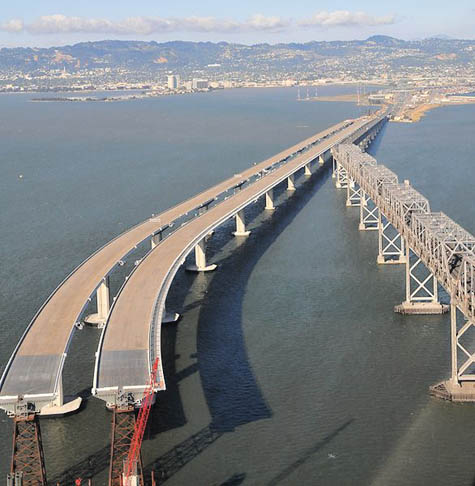 [Image: The Bay Bridge and its replacement; on the right is the piece that Rael San Fratello would like to see stabilized. Image via Wikipedia].
[Image: The Bay Bridge and its replacement; on the right is the piece that Rael San Fratello would like to see stabilized. Image via Wikipedia].And if it works for the Bay Bridge, they suggest, it could work for other disused bridges elsewhere.
"This proposal seeks to repurpose abandoned and closed bridges as sites of potential for parks, cultural centers and housing," the architects write in the project's accompanying PDF. In the process, they hope "to demonstrate the potential for re-purposing historic American bridge infrastructure as possible sites for sustainable urban housing and linear parks."
- The immense load capacity of rail bridges allows for the support of program beyond that of parks, suggesting the urbanization of bridges. While the current economic climate suggests a surplus of housing, the economic reality also suggests a push towards urbanization and often the “affordable” housing constructed in suburban environments, which encroaches on the rural, is not what is needed. Instead, by using abandoned bridges in urban areas, we are creating opportunities for sustainable low-cost housing within the urban realm—creating the potential for creative speculation among housing developers by expounding upon the nascent potential of a layered housing-park-bridge typology.

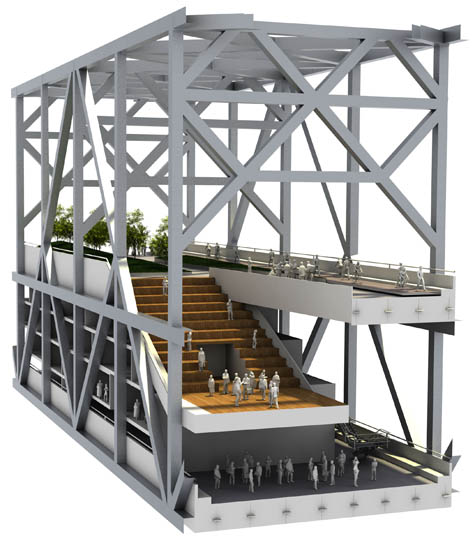
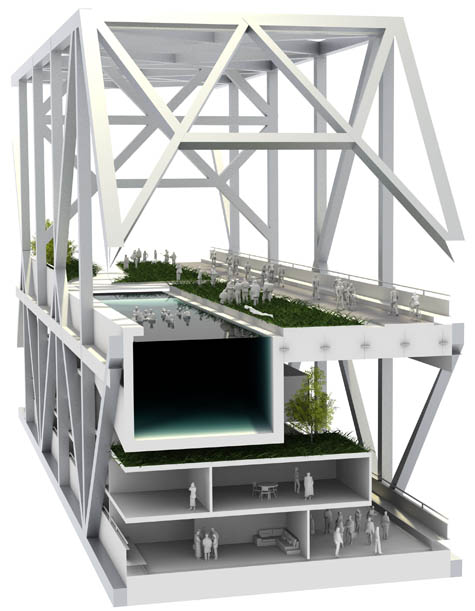 [Images: (top) Tennis court, bicycle path, and observation module; (middle) Outdoor auditorium; (bottom) swimming pool on the Bay Line by Ronald Rael and Virginia San Fratello].
[Images: (top) Tennis court, bicycle path, and observation module; (middle) Outdoor auditorium; (bottom) swimming pool on the Bay Line by Ronald Rael and Virginia San Fratello]. And, I have to admit, it would simply be cool:
- Imagine housing, recreational and cultural facilities connected to a continuous, lushly planted, green strip, floating above the water—an aerial garden, as the city's newest park through which you could walk and wander and enjoy the most spectacular views of the bay.
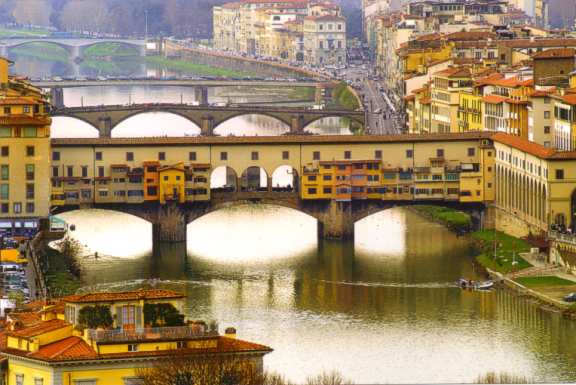

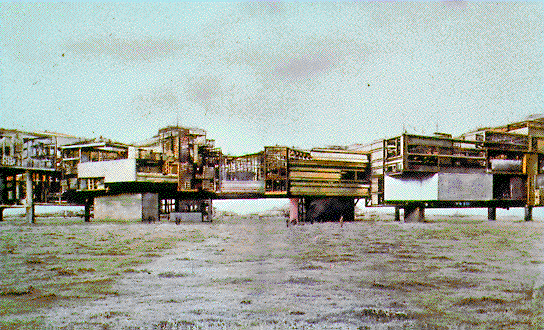
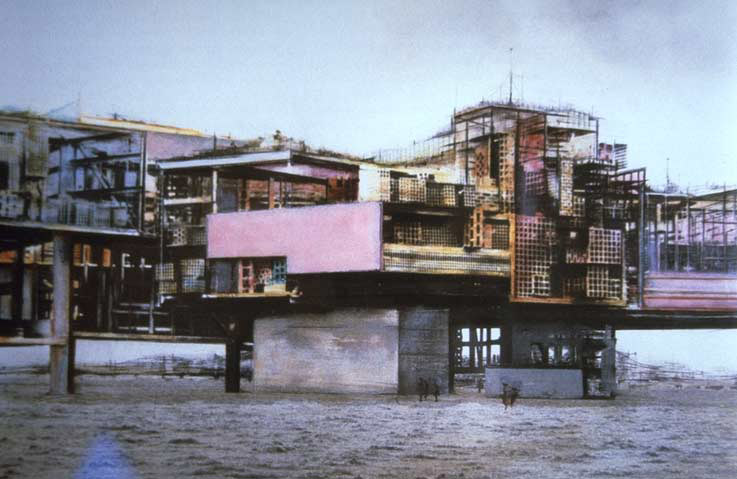 [Images: Other habitable bridge: (top) Florence's Ponte Vecchio; (second) a painting by Peter Jackson of "Old London Bridge"; (third and bottom) Constant's New Babylon].
[Images: Other habitable bridge: (top) Florence's Ponte Vecchio; (second) a painting by Peter Jackson of "Old London Bridge"; (third and bottom) Constant's New Babylon].In any case, as someone who literally never enjoyed driving across the Bay Bridge for seismic-safety reasons, I have to point out that this proposal still comes with its own set of earthquake-related issues. I was interested, however, to read in the Economist just this week that "there are few safe places to ride out an earthquake. Surprisingly, though, a recently constructed bridge is often one of them."
- Engineers have become good at designing bridges that are earthquake-resistant enough to preserve the lives of those caught crossing when a quake strikes. The problem is that the bridge is often unusable afterwards.
 [Image: Final render of the Bay Line by Ronald Rael and Virginia San Fratello].
[Image: Final render of the Bay Line by Ronald Rael and Virginia San Fratello].But what of bridges in non-seismic zones? In Sydney, for instance, due to the peninsular nature of walks along Cremorne Point and through Kirribilli, there are places where the Sydney Harbor Bridge appears not to be crossing over water at all, but standing over the rooftops of the city, anchored into the neighborhood. It looks more like a new kind of inland megastructure, strung above the streets and restaurants, like something designed by Perdido Street Station-era China Miéville, than a harbor bridge. An industrial cathedral of exposed ribs and steel tension lines, arcing up into the skyline.
So what if you hung houses from it? What amazing typologies of bolt-on architectural prosthetics could we create, if bridges were aerial foundations and they carried not cars or locomotives but schools and piazzas?
In fact, I'm reminded of this unexpectedly inspiring – structurally speaking – proposal by Skidmore, Owings & Merrill, which sought to string the suspension cables of a new pedestrian bridge from inside the nearby buildings of a rebuilt Leamouth Peninsula (click through to their image gallery for more).
 [Image: A proposal for London's Leamouth Peninsula by Skidmore, Owings & Merrill].
[Image: A proposal for London's Leamouth Peninsula by Skidmore, Owings & Merrill].Returning to Rael San Fratello's Bay Line, though, there are obviously still huge issues associated with the unusually catastrophic nature of structural failure when it comes to inhabitable bridges, as well as the financially prohibitive needs of regular maintenance, but treating suspension bridges simply as another type of district in the city is an undeniably interesting urban idea.
(Via Streetsblog SF and Ronald Rael. Meanwhile, Rael's recently published book Earth Architecture is an excellent and thoughtful survey of earthen structures across the world and throughout building history; Rael's old school blog, megablog, is also worth a read for its eye-popping and often literally world-altering architectural ambitions).
No comments:
Post a Comment